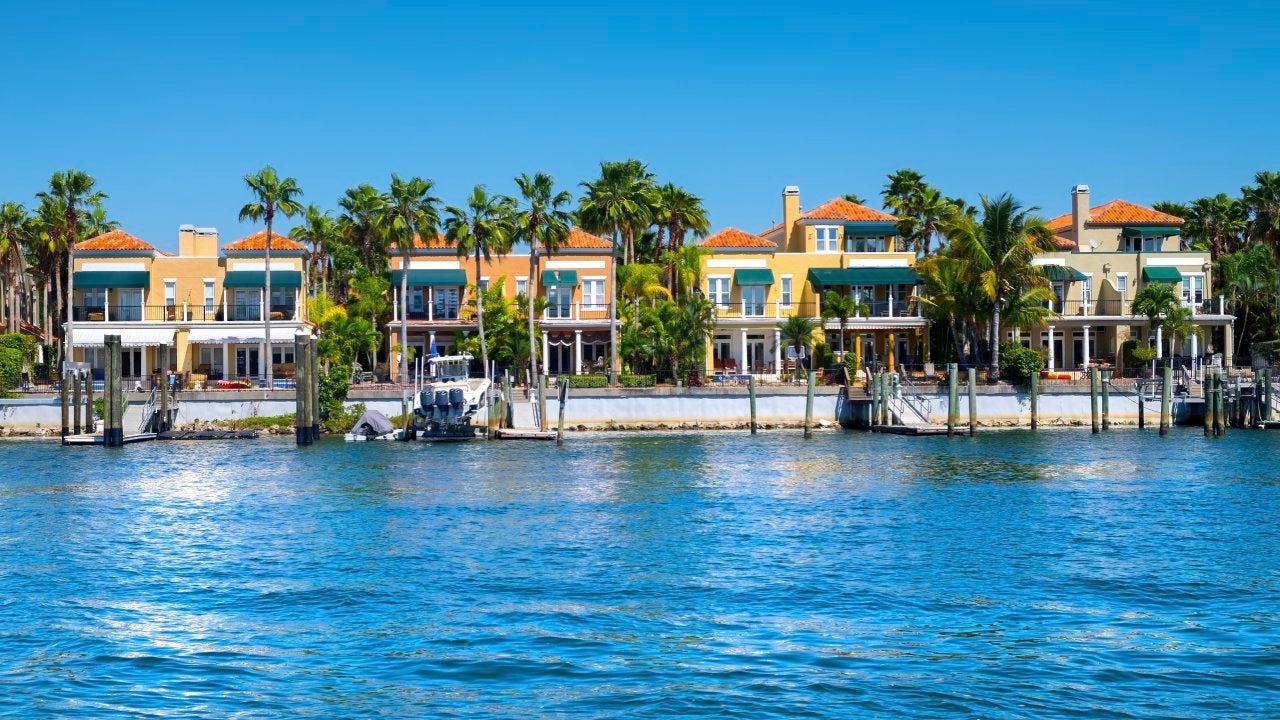Florida Housing Market | Bankrate
Loads of people from all over the country pack their bags and head south to sunny Florida. The state has led the country in net migration — people moving there from another state — for more than five years in a row, and the pandemic accelerated that population growth.
Florida’s warm weather and relatively low cost of living has long made it attractive for retirees, but it’s also a great spot for those still in their prime working years, whether they’re searching for an office environment or looking to log on from the beach.
While the state is clearly an appealing place to live, real estate doesn’t look quite as sunny as it used to: mortgage rates have skyrocketed, as has the cost of homeowners insurance, and homes stay on the market for much longer. Read on for everything you need to know about the Florida housing market.
Florida is big, covering more than 65,000 square miles. To get a sense of the pulse of buying and selling activity across the state, it’s important to remember that real estate is a hyper-local industry. What’s happening in Miami, where loads of wealthy out-of-staters have relocated, is much different than what’s going on in, say, Tallahassee.
And while the best places to live in Florida naturally include easy access to the beach, they also include inherent downsides and dangers, as evidenced by the horrific damage of Hurricane Ian along the Gulf Coast. Climate change could cause major long-term challenges for the Florida housing market: One McKinsey report projected that some coastal homes could lose 35 percent of their value by 2050 due to rising sea levels.
Whether you’re looking to buy or sell a house here, here’s some helpful data from Florida Realtors to consider.
- Median sale price: In August 2023, the state’s median sale price was $415,000. That’s up 2 percent from the year before and slightly above the national median, which as of August was $407,100.
- Sale-to-list price: Back in August 2022, buyers typically paid 98.5 percent of a home’s list price. That figure this year is down 1 percent to 97.5 percent — an indication that buyers might be gaining just a bit more leverage in the market.
- Days on market: The median time to contract for a single-family home was 27 days in August, significantly longer than the 16-day timeframe at the same time last year.
- All-cash deals: Many Florida buyers do not need to secure financing for the deal. Of the 22,917 single-family homes sold in August, more than 6,700 were purchased in cash.
- Inventory: August saw a 3-month supply of housing inventory across the state, which is up from 2.4 percent last year but still too low to meet demand.
- Closing costs: The state’s average closing costs total 2.3 percent of the home’s purchase price, according to research from ClosingCorp. On a median-priced $415,000 sale, that’s an additional $9,545.
Is it a buyer’s or seller’s market in the Sunshine State right now? A shortage of available inventory puts the power in the hands of the seller. But homes are spending much longer on the market before they sell, and they’re not selling for full asking price, which means buyers do have some leverage. Here’s what to know, depending on which side of the table you’re on.
Selling a home in Florida
Florida sellers still have the upper hand, simply because there aren’t enough homes available to meet demand. In August, there was just a 3-month supply of single-family homes; that’s around half of the 5 to 6 months necessary for a balanced market.
However, there are warning signals that sellers should consider. It’s taking 11 days longer for homes to go to contract now than it did last year, and overall sales in the state have dropped by 7.9 percent, according to Florida Realtors. In addition, homes have not sold for 100 percent of their asking price all year. So don’t get greedy with your pricing strategy right now — an elevated list price might scare off buyers, who are already feeling the pinch of higher mortgage rates.
Before you list, take steps to figure out what your house is worth, and price it competitively. You might even be able to attract an all-cash offer, which is fairly common in Florida: 29.3 percent of all sales closed in August were cash deals, per Florida Realtors data.
Buying a home in Florida
First, the good news: Prices here have held relatively steady recently, either remaining flat or rising very slightly for the past six months. Now, the bad news: They’re still pretty high. With a median price tag of $415,000, a 20 percent down payment for a typical Florida buyer would come to $83,000.
Many buyers have retreated in the current market conditions, with mortgage rates above 7 percent, so this may be a great time to avoid dealing with the high level of competition that shaped much of the past two years. If you go house hunting in Florida, keep these tips in mind:
- Compare cost of living: Keep in mind how much you’ll need to spend on other life essentials besides housing, as it can vary widely across Florida. For example, Bankrate’s cost of living calculator shows that life in Jacksonville is nearly 15 percent cheaper than in Fort Myers or Cape Coral.
- Get preapproved: Getting preapproved for a mortgage is a simple step that gives you a good idea of how much house you can afford. And having a preapproval letter means sellers will take you more seriously.
- Negotiate: The days of buyers waiving contingencies, engaging in bidding wars and doing basically anything to secure a home are gone. You aren’t at the full mercy of the market anymore — or at least not as much. Work with your real estate agent to make sure you aren’t offering more than you need to, and ask for concessions if your home inspection uncovers problems.
Rising mortgage rates and persistent inflation have fueled worries of a housing market crash nationwide. But expert predictions do not foresee a crash. A cataclysmic drop in prices similar to the housing crisis of 2007 and 2008, when clouds of foreclosures hung over the Sunshine State, is very unlikely. Instead, the Florida housing market seems poised for a cooldown with a soft landing.
Different locations in Florida may also have very different market forecasts. South Florida and major cities like Miami and Orlando are in high demand and may be more recession-resistant than northern and more rural portions of the state. Median prices in particular metro areas can give you a good idea of what to expect: For example, per Redfin data, the August median in Sebring, right in the center of the peninsula, was just $226,990, and in the panhandle city of Tallahassee it was $276,250. Meanwhile, Miami’s median price was $560,000, and in Naples, on the Gulf Coast, it was $670,000.
Whether you’re buying or selling in Florida, don’t try to navigate the market alone. Having an experienced real estate agent on your side can help you avoid mistakes and ease the stress of negotiations and paperwork. Look for someone who knows the area you’re in well, and if they know your specific neighborhood, all the better. Before you sign a contract with a Realtor, whether you’re looking in much-visited cities like Miami or Orlando or in less touristy parts of the state, interview several candidates to make sure you’re the right fit.
Important note about Florida homeowners insurance
- The home insurance market in Florida is in crisis. Since 2017, many insurance carriers have left the state, gone insolvent or tightened their underwriting restrictions, making it difficult for homeowners to find coverage. Many of the companies that remain have chosen not to renew existing policies, leaving owners in the lurch.
- Fraudulent roofing claims are mostly to blame, and the devastating effects of Hurricane Ian in September 2022 complicated the issue further. According to a report from the governor’s office, Florida accounts for 79 percent of the country’s home insurance lawsuits.
- New insurance-reform laws went into effect in 2022 to try to stabilize the situation, but it may be some time before these laws produce meaningful results, and homeowners could see premiums that exceed several thousand dollars a year. Before you buy a Florida home, consult closely with your real estate agent, and possibly a local attorney, to determine whether the property will be insurable at a cost you can afford.
-
They’re rising, slowly but steadily. According to data from Florida Realtors, the median home price in August was $415,000, which is a 2 percent year-over-year increase. The state remains one of the top markets people move to, and its increasing population will likely keep the market robust.
-
The Florida market is full of mixed signals. On one hand, migration to the state is high, as are home prices, plus there is still a too-low supply of homes, all of which give sellers more power and make it a challenging time to buy. However, there are positive signs for buyers as well: Homes are spending a much longer time on the market than they used to, and when they do sell they are not getting their full asking price. So buyers do have some leverage there. Before you go into contract on a Florida home, be sure you understand how much it will cost to insure, as homeowners insurance rates in the state are extremely high.



